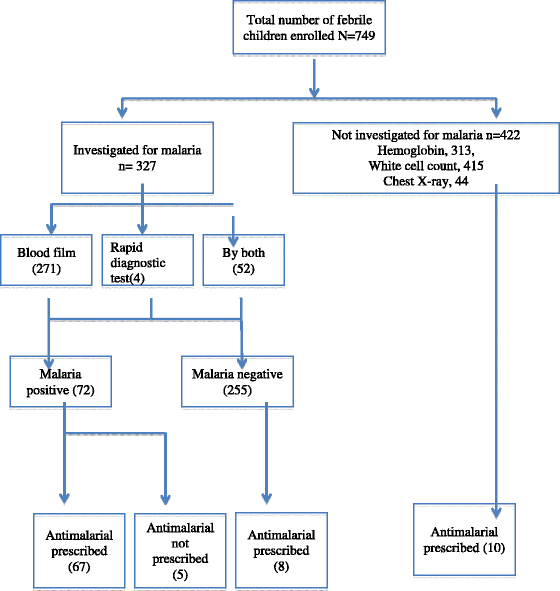Poor adherence to the malaria management protocol among health workers attending under-five year old febrile children at Omdurman Hospital, Sudan
- PMID: 25627166
- PMCID: PMC4318364
- DOI: 10.1186/s12936-015-0575-9
Poor adherence to the malaria management protocol among health workers attending under-five year old febrile children at Omdurman Hospital, Sudan
Abstract
Background: In spite of the World Health Organization recommendations for the treatment of malaria, febrile patients are still infrequently tested and erroneously treated for malaria. This study aimed to investigate the adherence to malaria national protocol for the management of malaria among under five years old children.
Methods: A cross sectional hospital-based study was conducted during the period from September through December 2013 among febrile children below the age of five years attending the outpatient department of Omdurman Children Hospital, Sudan. Demographic, clinical and laboratory data [blood film, rapid diagnostic test (RDTs), haemoglobin, WBCs and chest X ray] and anti-malarials and/or antibiotics prescription were recorded.
Results: A total of 749 febrile children were enrolled. The mean (SD) age was 37.51 (41.6) months. Less than a half, (327, 43.7%) of children were investigated for malaria using microscopy (271, 82.9%), RDT (4, 1.2%) or both (52, 15.9%). Malaria was not investigated for more than a half, (422, 56.3%) however investigations targeting other causes of fever were requested for them. Malaria was positive in 72 (22%) of the 327 investigated children. Five (1.6%) out of 255 with negative malaria tests were treated by an anti-malarials. Quinine was the most frequently prescribed anti-malarials (65, 72.2%) then artemisinin-based combination therapy (ACT) (2, 27.8%). The majority of the 749 children (655, 87.4%) were prescribed an antibiotic.
Conclusion: There is a poor adherence to malaria management protocol in Sudan among physicians treating children below five years of age. There was a high rate of antibiotic prescription needs.
Figures
Similar articles
-
Prescription practices for malaria in Mozambique: poor adherence to the national protocols for malaria treatment in 22 public health facilities.Malar J. 2015 Dec 1;14:483. doi: 10.1186/s12936-015-0996-5. Malar J. 2015. PMID: 26628068 Free PMC article.
-
Trends in malaria case management following changes in the treatment policy to artemisinin combination therapy at the Mbakong Health Centre, Cameroon 2006-2012: a retrospective study.Acta Trop. 2015 Oct;150:100-6. doi: 10.1016/j.actatropica.2015.06.014. Epub 2015 Jun 18. Acta Trop. 2015. PMID: 26095044
-
Rapid diagnostic tests for malaria and health workers' adherence to test results at health facilities in Zambia.Malar J. 2014 May 2;13:166. doi: 10.1186/1475-2875-13-166. Malar J. 2014. PMID: 24885996 Free PMC article.
-
Factors influencing health workers' adherence to malaria treatment guidelines in under-five children in Nigeria: A scoping review.Malariaworld J. 2024 Oct 15;15:11. doi: 10.5281/zenodo.13934643. eCollection 2024. Malariaworld J. 2024. PMID: 39502332 Free PMC article.
-
[Guideline for febrile children in the hospital setting; relevance for general practitioners and paediatricians].Ned Tijdschr Geneeskd. 2014;158:A7331. Ned Tijdschr Geneeskd. 2014. PMID: 25027213 Review. Dutch.
Cited by
-
Healthcare Professional Preferences for Prescribing Artemisinins and Quinine for Malaria in Burundi.East Afr Health Res J. 2021;5(2):174-181. doi: 10.24248/eahrj.v5i2.670. Epub 2021 Nov 15. East Afr Health Res J. 2021. PMID: 35036845 Free PMC article.
-
Quality of Malaria Case Management and Reporting at Public Health Facilities in Six Health Districts in Guinea, 2018.Am J Trop Med Hyg. 2019 Jul;101(1):148-156. doi: 10.4269/ajtmh.19-0150. Am J Trop Med Hyg. 2019. PMID: 31074408 Free PMC article.
-
Knowledge and practices regarding malaria and the National Treatment Guidelines among public health workers in Equatorial Guinea.Malar J. 2021 Jan 7;20(1):21. doi: 10.1186/s12936-020-03528-7. Malar J. 2021. PMID: 33413402 Free PMC article.
-
Management of uncomplicated malaria among children under five years at public and private sector facilities in Mali.BMC Public Health. 2020 Dec 9;20(1):1888. doi: 10.1186/s12889-020-09873-1. BMC Public Health. 2020. PMID: 33298011 Free PMC article.
-
Prescription practices for malaria in Mozambique: poor adherence to the national protocols for malaria treatment in 22 public health facilities.Malar J. 2015 Dec 1;14:483. doi: 10.1186/s12936-015-0996-5. Malar J. 2015. PMID: 26628068 Free PMC article.
References
-
- World Health Organization . Antimalarial drug combination therapy: report of a WHO technical consultation. Geneva, Switzerland: World Health Organization; 2001.
-
- World Health Organization . Guidelines for the treatment of malaria (second edition) Geneva, Switzerland: World Health Organization; 2010.
MeSH terms
Substances
LinkOut - more resources
Full Text Sources
Other Literature Sources
Medical


